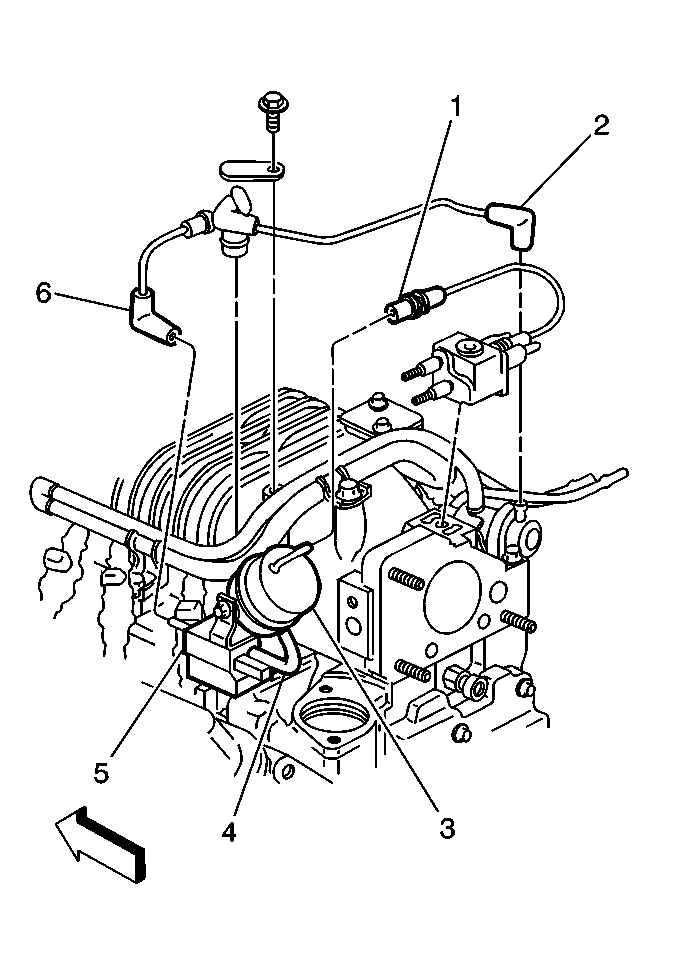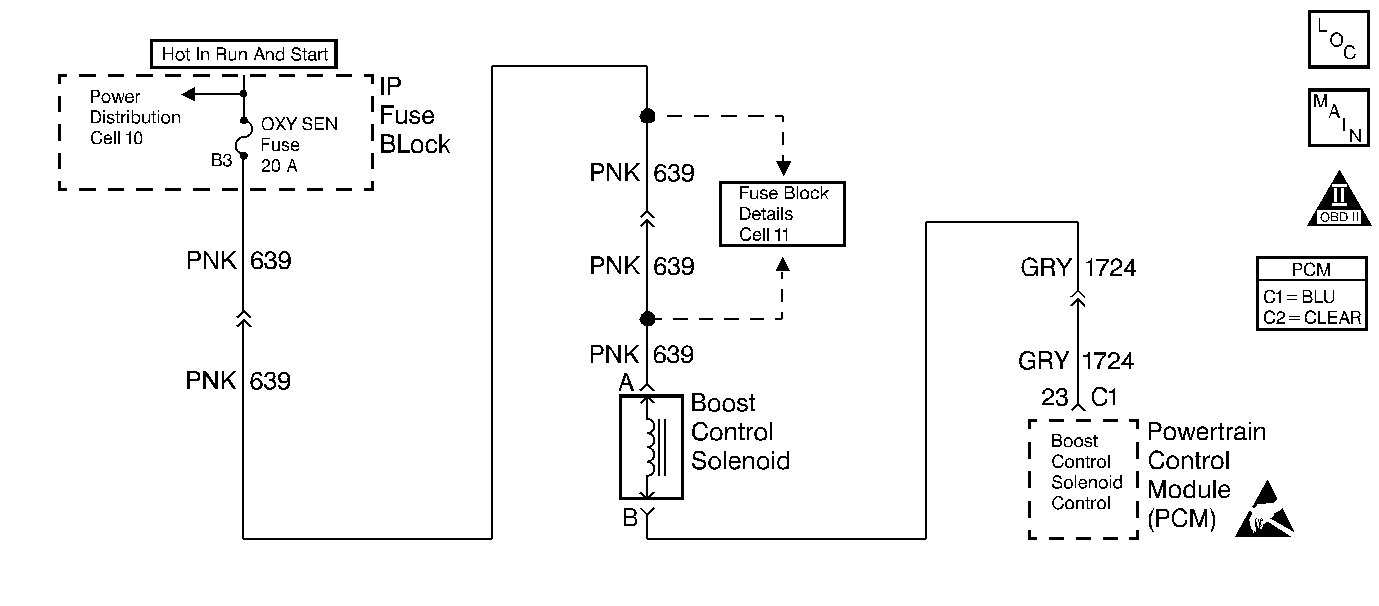If the Boost Control System Check has been performed and no electrical
or vacuum related fault is noted, check for the following conditions:
An intermittent may be caused by a poor connection, rubbed through wire
insulation, or a wire broken inside the insulation. Check for the following
conditions:
Number(s) below refer to the step number(s) on the Diagnostic Table.
Boost Control System Functional Check (VIN 1 Only)
Step
| Action
| Value(s)
| Yes
| No
|
1
| Was the On-Board Diagnostic
(OBD) System Check performed?
| --
|
Go to Step 2
| Go to the
Powertrain On Board Diagnostic (OBD) System Check
|
2
|
- Disconnect the Boost Control Solenoid electrical connector.
- Turn ON the ignition switch.
- Install a test light between the ignition feed circuit at the
Boost Control Solenoid harness connector and engine ground.
Is the test light ON?
| --
|
Go to Step 3
|
Go to Step 11
|
3
| Connect the test light between
the Boost Control Solenoid harness connector terminals.
Is the test light ON?
| --
|
Go to Step 14
|
Go to Step 4
|
4
|
- Select Boost Control Solenoid output control with scan tool.
- Observe the test light while turning the Boost Control Solenoid
output ON with the scan tool.
Is the test light ON when the Boost Control Solenoid output is commanded
ON?
| --
|
Go to Step 5
|
Go to Step 16
|
5
|
- Reconnect the Boost Control Solenoid electrical connector.
- Disconnect the boost signal hose between the Boost Control Solenoid
and the Bypass Valve Actuator. Refer to

- Connect a vacuum gauge to read the boost signal from the Boost
Control Solenoid.
- Start the engine and idle in Park.
- Observe the vacuum gauge reading.
Does the vacuum gauge indicate near the specified value?
| 0 in. Hg
|
Go to Step 6
|
Go to Step 17
|
6
|
- Turn the Boost Control Solenoid OFF with the scan tool.
- Observe the vacuum gauge.
Does the vacuum gauge indicate greater than the specified value with
the Boost Control Solenoid turned OFF?
| 15 in. Hg
|
Go to Step 7
|
Go to Step 10
|
7
|
- Check for a restriction in the boost signal hose between the Boost
Control Solenoid and the Bypass Valve Actuator. Refer to

- If a problem is found, repair as necessary.
Was a problem found?
| --
|
Go to Step 21
|
Go to Step 8
|
8
|
- Reconnect the boost signal hose between the Boost Control Solenoid
and the Bypass Valve Actuator.
- Connect the vacuum gauge to read the inlet vacuum signal to the
Bypass Valve Actuator. Refer to

- Start the engine and idle in Park.
- Observe the vacuum gauge reading.
Does the vacuum gauge indicate greater than the specified value?
| 15 in. Hg
| Refer to Diagnostic Aids
|
Go to Step 9
|
9
| Repair the restriction in the inlet vacuum
signal hose to the Bypass Valve Actuator or blocked inlet vacuum source.
Refer to

Is action complete?
| --
|
Go to Step 21
| --
|
10
|
- Check for a restriction in the boost source hose to the Boost
Control Solenoid. Refer to

- If a problem is found, repair as necessary.
Was a problem found?
| --
|
Go to Step 21
|
Go to Step 18
|
11
| Check the fuse for the Boost Control Solenoid ignition feed circuit.
Is the fuse blown?
| --
|
Go to Step 12
|
Go to Step 13
|
12
| Locate and repair short to ground in the ignition feed circuit. Refer to Repair
Procedures in Electrical Diagnosis.
Is action complete?
| --
|
Go to Step 21
| --
|
13
| Locate and repair open in the ignition feed
circuit to the Boost Control Solenoid. Refer to Repair Procedures in Electrical
Diagnosis.
Is action complete?
| --
|
Go to Step 21
| --
|
14
|
- Turn OFF the ignition switch.
- Disconnect the PCM.
- Turn ON the ignition switch.
- Observe the test light connected between the boost control solenoid
connector terminals.
Is the test light ON?
| --
|
Go to Step 15
|
Go to Step 20
|
15
| Locate and repair short to ground in Boost Control Solenoid driver circuit.
Refer to Repair Procedures in Electrical Diagnosis.
Is action complete?
| --
|
Go to Step 21
| --
|
16
|
- Turn OFF the ignition switch.
- Disconnect the PCM.
- Turn ON the ignition switch.
- Check the Boost Control Solenoid driver circuit for an open or
a short to voltage.
- If a problem is found, repair as necessary. Refer to Repair Procedures
in Electrical Diagnosis.
Was a problem found?
| --
|
Go to Step 21
|
Go to Step 19
|
17
|
- Check for poor terminal connections at the Boost Control Solenoid.
- If a problem is found, repair as necessary. Refer to Repair Procedures
in Electrical Diagnosis.
Was a problem found?
| --
|
Go to Step 21
|
Go to Step 18
|
18
| Replace the Boost Control Solenoid. Go to
Boost Control Solenoid
.
Is action complete?
| --
|
Go to Step 21
| --
|
19
|
- Check the Boost Control Solenoid driver circuit for a poor terminal
connection at the PCM.
- If a problem is found, repair as necessary. Refer to Repair Procedures
in Electrical Diagnosis.
Was a problem found?
| --
|
Go to Step 21
|
Go to Step 20
|
20
| Replace the PCM.
Important: Replacement PCM must be programmed. Go to
Powertrain Control Module Replacement/Programming
.
Is action complete?
| --
|
Go to Step 21
| --
|
21
|
- Disconnect the inlet vacuum signal line from the bypass valve
actuator. Refer to

- Engine idling.
- Select output tests, Boost Sol. on the scan tool.
- Observe MAP reading on the scan tool while cycling the boost solenoid
ON and OFF.
Does the MAP value decrease while the boost sol. is commanded ON and
increase while the boost sol. is commanded OFF?
| --
|
Go to Step 22
|
Go to Step 2
|
22
| Reconnect the inlet vacuum signal line to
the bypass valve actuator. Refer to

Is action complete?
| --
| System
OK
| --
|


